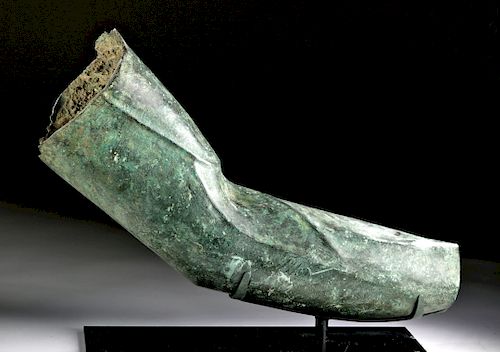Large Roman Bronze Statue of Right Arm
Lot 89
About Seller
Artemis Fine Arts
686 S Taylor Ave, Ste 106
Louisville, CO 80027
United States
Selling antiquities, ancient and ethnographic art online since 1993, Artemis Gallery specializes in Classical Antiquities (Egyptian, Greek, Roman, Near Eastern), Asian, Pre-Columbian, African / Tribal / Oceanographic art. Our extensive inventory includes pottery, stone, metal, wood, glass and textil...Read more
Estimate:
$18,000 - $25,000
Absentee vs Live bid
Two ways to bid:
- Leave a max absentee bid and the platform will bid on your behalf up to your maximum bid during the live auction.
- Bid live during the auction and your bids will be submitted real-time to the auctioneer.
Bid Increments
| Price | Bid Increment |
|---|---|
| $0 | $25 |
| $300 | $50 |
| $1,000 | $100 |
| $2,000 | $250 |
| $5,000 | $500 |
| $10,000 | $1,000 |
| $20,000 | $2,500 |
| $50,000 | $5,000 |
| $100,000 | $10,000 |
| $200,000 | $20,000 |
About Auction
By Artemis Fine Arts
Jun 20, 2019
Set Reminder
2019-06-20 10:00:00
2019-06-20 10:00:00
America/New_York
Bidsquare
Bidsquare : Ancient / Ethnographic From Around the World
https://www.bidsquare.com/auctions/artemis-gallery/ancient-ethnographic-from-around-the-world-4217
Around the world & back in time - be amazed at the treasures you will find. Antiquities from Egypt, Greece, Italy and the Near East, Asian, Pre-Columbian, African / Tribal / Oceanic, Native American, Spanish Colonial, Russian Icons, Fine Art, much more! All categories, all price ranges.. all legal Artemis Fine Arts info@artemisgallery.com
Around the world & back in time - be amazed at the treasures you will find. Antiquities from Egypt, Greece, Italy and the Near East, Asian, Pre-Columbian, African / Tribal / Oceanic, Native American, Spanish Colonial, Russian Icons, Fine Art, much more! All categories, all price ranges.. all legal Artemis Fine Arts info@artemisgallery.com
- Lot Description
Roman, Imperial Period, ca. 2nd to 3rd century CE. A cast bronze section of a right arm from a more than life-size statue of a man or god. Once again, this piece is oversized - suggesting that it came from a monumental statue - I am not going out on a limb here (no pun intended). Note the naturalistic rendering; the sculptor delineated the arm with a naturalistically bent elbow and palpable musculature with popping veins to imply flexing. Size: 20.5" W x 12.25" H (52.1 cm x 31.1 cm); 14.25" H (36.2 cm) on included custom stand. Dimensions of hollow within upper arm 5.25" W x 7" H (13.3 cm x 17.8 cm)
In the Classical World, bronze was the preferred material for dedicatory sculpture. Due to its high tensile strength, bronze enabled a sculptor to create figures with impressive poses. Stone, on the other hand, presented more limitations. Unfortunately, though many bronze sculptures were created during antiquity, most have vanished with far fewer surviving in comparison to their marble counterparts, as bronze sculptures were frequently melted down, so that the bronze could be reused. Because of this, surviving Roman bronzes like this example are very special.
In addition, life-size or monumental statues were built via the lost-wax casting method and sections were soldered together to create the figure. Due to this production method, when statues fell during battle or natural disasters, these joins were weak points. Hence we have more bronze fragments than intact statues today.
Provenance: private East Coast, USA collection; ex-Joe Gerena Fine Arts, New York, USA, acquired in 1995
All items legal to buy/sell under U.S. Statute covering cultural patrimony Code 2600, CHAPTER 14, and are guaranteed to be as described or your money back.
A Certificate of Authenticity will accompany all winning bids.
We ship worldwide and handle all shipping in-house for your convenience.
#145877A fragment from a larger, oversized statue. Encrusted interior walls, coated with pebbles. A gorgeous green patina has developed over the ages.Condition
- Shipping Info
-
All shipping is handled in-house for your convenience. Your invoice from Artemis Gallery will include shipping calculation instructions. If in doubt, please inquire BEFORE bidding for estimated shipping costs for individual items.
-
- Buyer's Premium



 EUR
EUR CAD
CAD AUD
AUD GBP
GBP MXN
MXN HKD
HKD CNY
CNY MYR
MYR SEK
SEK SGD
SGD CHF
CHF THB
THB














